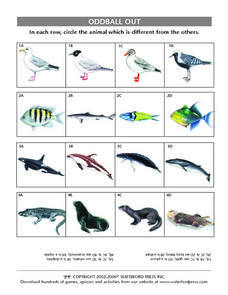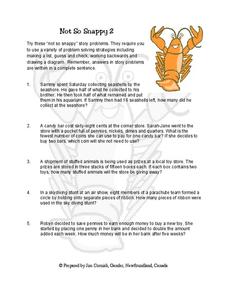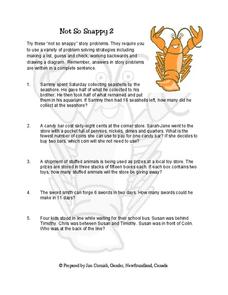Curated OER
Exploring Marine Objects
Students identify the sources of water on Earth. In this life science lesson, students list the different plants and animals that live in the ocean. They explore marine objects in the lab and draw them.
Curated OER
Oddball Out: Sea Animals
In this problem solving worksheet, young scholars analyze a row of pictures of various animals to determine which creature is different from the others pictured.
Curated OER
Oddball Out: Birds, Fishes, Marine Mammals
In this science worksheet, students analyze 4 animal pictures in a row. Students circle the animal which is different from the others. There are 4 rows of pictures. Answers are provided upside down at the bottom of the page.
Curated OER
Lesson Plan fo The Magic Eyes of Little Crab
Interested in a "how and why" story to read with young students? In this storytelling lesson, readers will discuss sea creatures, focusing on practicing new terminology through retelling the story. This resource provides a list of...
Curated OER
Classification and Adaptations- Streams, Rivers, and Lakes - Where the Land Meets the Sea And Caribbean Reef
In this science worksheet set, students answer 14 short answer questions about the classification and adaptation of life in streams, rivers, and lakes. They also answer 15 questions about life "Where the Land Meets the Sea" and in a...
Curated OER
Classification and Identification
Students, after exploring and analyzing diagrammatic and taxonomic keys and their association to marine sciences, identify and classify objects and organisms based on visual attributes/characteristics. They research and create their own...
Curated OER
3rd grade life science
In this life science worksheet, 3rd graders answer multiple choice questions about plants, birds, habitats, and more. Students complete 20 questions.
Curated OER
Moon Snails
In this moon snails worksheet, students read a 2 page article on moon snails, define 8 vocabulary words relating to moon snails and answer 7 short answer questions relating to the article.
Curated OER
Aquatic Ecosystems
Students study the diversity of marine life and their habitats. For this aquatic ecosystems lesson students complete a lab activity and experiment.
Curated OER
Not So Snappy 2
For this math worksheet, students learn to use problem solving strategies such as making a list, guess and check, working backwards and drawing a diagram. Students read and solve 6 sentences.
Curated OER
Not So Snappy 2
In this order of operations (i.e., addition, subtraction, multiplication, division) worksheet, students solve 5 word problems demonstrating their understanding of the concept.
Curated OER
The Environments of Big Sur -- Which Do We Protect?
Young scholars investigate the geological, climatic, and biological features of Big Sur. They watch a video, conduct Internet research, and create a script and images in the form of an outline in a simulation of an environmental group.
Curated OER
Life Science Review for Grade 4
In this life science review for grade 4 worksheet, 4th graders answer 25 multiple choice questions in standardized test format about life science.
Curated OER
Stewardship Activities
In this ocean pollution worksheet, students read the stewardship activities for ocean pollution. Students list 3 ways to help reduce pollution. Students then draw or write the items in the correct order of decomposition along the timeline.
Curated OER
John Muir: Long Ago and Now
Students explore nature objects brought indoors such as rocks, seeds, leaves and shells to identify where the objects came from. They hear stories about John Muir's life and make booklets about nature areas they enjoy.
Read Works
Read Works: Explore the Seashore
[Free Registration/Login Required] An informational text about different animals that can be found along the seashore including: crabs, seals, sand dollars, sea gulls, and sea stars. A question sheet is available to help students build...
Other
Life on Australian Seashores: Molluscs
Provides a very basic look at the anatomy of a mollusk including the proposed anatomy of what the mollusc ancestor probably looked like. Hyperlinks to individual animals in the mollusk group.
















